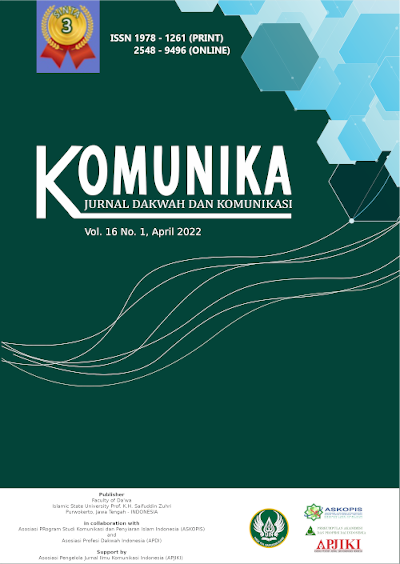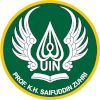Semiotic Analysis of Feminism in Joko Anwar’s Movie “Perempuan Tanah Jahanam”
DOI:
https://doi.org/10.24090/komunika.v16i1.6001Keywords:
Perempuan Tanah Jahanam Movie, Semiotics of Roland Barthes, FeminismAbstract
Movies be a part of entertainment media that represent the state of the community and record the dynamism of nowadays's social society, ranging from inequality of poverty to gender injustice. The Perempuan Tanah Jahanam movie is a gore horror genre featuring female actors. Its story focuses on four women as a lead female actresses. Joko Anwar as director, presents and describes female actors not solely as supernumerary and accessories in movies. The purpose of this study is to explore the value of feminism in the Perempuan Tanah Jahanam movie through signs and markers using Roland Barthes' semiotic analysis method, which also employs the radical and postmodern feminism concept inspired by Rosemarie Putman tong. Based on this study's analysis, it is concluded that women are capable and control themselves over their bodies. Women refuse to follow the public perspective that women are powerless and must always propose to male protectors. Women are independent and dare to refuse sexual abuse. The film reflects feminism in how female actresses play roles in Perempuan Tanah Jahanam's movie.Downloads
References
Al Qurtuby, S. (2018, Oktober). Menimbang Fatwa Rokok NU dan Muhammadiyah. Sumber: https://www.nu.or.id/opini/menimbang-fatwa-rokok-nu-dan-muhammadiyah-J0y2U
Ardianto, E. (2005). Komunikasi Massa Suatu Pengantar. PT Remaja Rosdakarya.
Ardianto, E. (2009). Komunikasi Massa Suatu Pengantar (Edisi Revisi (cetakan kedua)). Simbiosa Rekatama Media.
Biran, M. Y. (2009). Sejarah film 1900-1950: Bikin Film di Jawa. Komunitas Bambu.
Dewi, M. E., Ssos, C. N. S., & Ikom, M. (n.d.). WACANA KETIDAKSETERAAN GENDER PADA FILM SITI. 8.
Djamaluddin, A. (2018). WANITA KARIER DAN PEMBINAAN GENERASI MUDA. Jurnal Al-Maiyyah, Volume 11 No. 1 Januari-Juni 2018.
Effendy, H. (2006). Komunikasi Massa Suatu Pengantar Edisi Revisi (cetakan kedua). Panduan.
Elvianaro, A. (2007). Filsafat Ilmu Kounikasi (cetakan pertama). Simbiosa Rekanama Media.
Fabriar, S. R. (2013). POTRET PEREMPUAN DALAM FILM. 9, 18.
famous.id. (2017). Hal-Hal Mistis yang Masih Dipercaya Orang Indonesia. https://www.brilio.net/video/comedy/hal-hal-mistis-yang-masih-dipercaya-orang-indonesia-170130o.html
Fatonah, T. (n.d.). Sinopsis Perempuan Tanah Jahanam: Terungkap Rahasia Kelam Keluarga Jahanam. https://www.matamata.com/life/2021/06/09/182759/sinopsis-perempuan-tanah-jahanam-terungkap-rahasia-kelam-keluarga-jahanam
Hafied, C. (2008). Pengantar Ilmu Komunikasi. PT Raja Grafindo Persada.
Ismail, U. (1983). Mengupas Film. Sinar Harapan.
Kasiyan. (2008). Manipulasi dan Dehumanisasi Perempuan Dalam Iklan (cetakan pertama). Ombak.
Leurima, S. (2019, June 8). Stigma Buruk tentang Perempuan yang Suka Keluar Malam. https://www.kompasiana.com/abikenleumar/5cfac7bcc01a4c091f49e9a2/stigma-buruk-bagi-perempuan-keluar-malam
muftisany, hafidz. (2014, Agustus). Hukum Wanita Bekerja di Luar Rumah pada Malam Hari. https://www.republika.co.id/berita/nb1xwa3/hukum-wanita-bekerja-di-luar-rumah-pada-malam-hari
Muslimah, N. D., Suyitno, S., & Purwadi, P. (2019). PERJUANGAN TOKOH PEREMPUAN JAWA DALAM NOVEL THE CHRONICLE OF KARTINI KARYA WIWID PRASETYO (KAJIAN FEMINISME DAN NILAI PENDIDIKAN KARAKTER). Basastra: Jurnal Bahasa, Sastra, dan Pengajarannya, 7(1), 125. https://doi.org/10.20961/basastra.v7i1.35510
Noviani, R. (n.d.). KONSEP DIRI REMAJA DALAM FILM INDONESIA: ANALISIS WACANA ATAS FILM REMAJA INDONESIA TAHUN 1970-2000-AN. 1(1), 15.
Nuryati, N. (n.d.). FEMINISME DALAM KEPEMIMPINAN. Universitas Islam Negeri (UIN) Raden Fatah Palembang, Vol 15 No 2 (2015): Istinbath. http://jurnal.radenfatah.ac.id/index.php/istinbath/article/view/792/700
Ritzer, G. & G., Douglas J. (2004). Teori Sosiologi Modern. Kencana.
Rohmad. (2021, Desember). Khutbah Jumat: Jangan Percaya kepada Dukun dan Peramal! Sumber: https://Islam.nu.or.id/khutbah/khutbah-jumat-jangan-percaya-kepada-dukun-dan-peramal-NvunV
Rohmaniyah, I. (2009). Gender dan Konstruksi perempuan dalam agama. Jurnal Studi llmu-iImu AI-Qur’an dan Hadis, Vol. io, No. 2, Juli 2009, 24.
Rosemarie Putnam, T. (2014). Feminist Thought: Pengantar Paling Komprehensif kepada Arus Utama Pemikiran Feminis. Jalasutra.
Shadily, H. (1980). Sensiklopedia Idonesia. Ikhtisar Baru-Van House.
Sobur, A. (2006). Analisis Teks Media. PT Remaja Rosdakarya.
Sobur, A. (2013). Semiotika Komunikasi. PT Remaja Rosdakarya.
Toni, A. (2019). Wacana Kepemimpinan Perempuan dalam Film ‘Opera Jawa’ Karya Garin Nugroho. 16.
Vera, N. (2014). Semiotika Dalam Riset Komunikasi. Ghalia Indonesia.
Wibowo, I. S. W. (2011). Semiotika Komunikasi. Mitra Wacana Media.
zainuddin. (2020). Kontruksi gender dan agama terhadap mahasiswi perokok (studi kasus mahasiswi prokok Yogyakarta) uin sunan kalijaga Yogyakarta.

Downloads
Published
Issue
Section
License
Copyright (c) 2022 Elok Nuriyatur Rosyidah, Akhmad Rifai

This work is licensed under a Creative Commons Attribution-ShareAlike 4.0 International License.
Authors who publish with this journal agree to the following terms:
- Authors retain copyright and grant the journal right of first publication with the work simultaneously licensed under a Creative Commons Attribution-ShareAlike 4.0 International License that allows others to share the work with an acknowledgement of the work's authorship and initial publication in this journal.
- Authors are able to enter into separate, additional contractual arrangements for the non-exclusive distribution of the journal's published version of the work (e.g., post it to an institutional repository or publish it in a book), with an acknowledgement of its initial publication in this journal.
- Authors are permitted and encouraged to post their work online (e.g., in institutional repositories or on their website) prior to and during the submission process, as it can lead to productive exchanges, as well as earlier and greater citation of published work (See The Effect of Open Access).


























